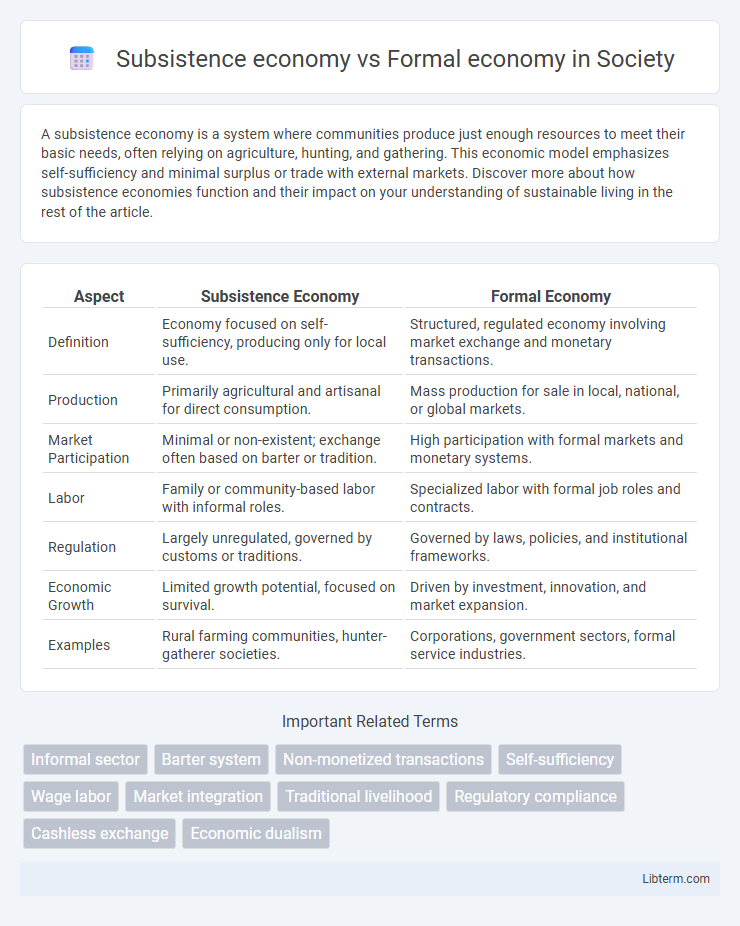A subsistence economy is a system where communities produce just enough resources to meet their basic needs, often relying on agriculture, hunting, and gathering. This economic model emphasizes self-sufficiency and minimal surplus or trade with external markets. Discover more about how subsistence economies function and their impact on your understanding of sustainable living in the rest of the article.
Table of Comparison
| Aspect | Subsistence Economy | Formal Economy |
|---|---|---|
| Definition | Economy focused on self-sufficiency, producing only for local use. | Structured, regulated economy involving market exchange and monetary transactions. |
| Production | Primarily agricultural and artisanal for direct consumption. | Mass production for sale in local, national, or global markets. |
| Market Participation | Minimal or non-existent; exchange often based on barter or tradition. | High participation with formal markets and monetary systems. |
| Labor | Family or community-based labor with informal roles. | Specialized labor with formal job roles and contracts. |
| Regulation | Largely unregulated, governed by customs or traditions. | Governed by laws, policies, and institutional frameworks. |
| Economic Growth | Limited growth potential, focused on survival. | Driven by investment, innovation, and market expansion. |
| Examples | Rural farming communities, hunter-gatherer societies. | Corporations, government sectors, formal service industries. |
Introduction to Subsistence and Formal Economies
Subsistence economies rely on self-sufficiency, where communities produce primarily for their own consumption using traditional methods and minimal market interaction. Formal economies involve structured market systems, regulated by laws and institutions, where goods and services are exchanged for profit and economic growth is measured through indicators like GDP. Understanding the distinctions between these two economic types highlights differences in production methods, resource allocation, and economic integration into global markets.
Defining Subsistence Economy
A subsistence economy primarily relies on natural resources and traditional methods to fulfill basic needs, emphasizing self-sufficiency over market exchanges. It is characterized by small-scale production, minimal surplus, and limited participation in formal trade systems. Unlike the formal economy, which depends on monetized transactions, regulations, and wage labor, subsistence economies often operate outside centralized economic frameworks, sustaining communities through agriculture, hunting, fishing, and barter.
Defining Formal Economy
The formal economy consists of economic activities that are officially registered, regulated, and taxable under government laws, encompassing sectors such as manufacturing, services, and trade. It features standardized labor contracts, legal protections for workers, and access to financial services, contributing to measurable GDP and employment statistics. Unlike subsistence economies, the formal economy facilitates market transactions and economic growth through formal institutions and regulatory frameworks.
Key Characteristics of Subsistence Economies
Subsistence economies are characterized by self-sufficiency, where households produce most of what they consume, relying heavily on agriculture, hunting, fishing, and gathering. These economies typically operate with minimal surplus production, limited market exchange, and informal labor arrangements focused on meeting immediate survival needs. Unlike formal economies, subsistence systems lack extensive monetary transactions, formal employment structures, and institutional regulation.
Key Characteristics of Formal Economies
Formal economies are characterized by structured regulatory frameworks, legal recognition, and consistent taxation systems that ensure economic activities are monitored and recorded. Businesses within formal economies adhere to labor laws, standardized accounting practices, and often participate in governmental programs, promoting transparency and stability. The presence of formal financial institutions facilitates access to credit, investment, and international trade, distinguishing these economies from subsistence or informal systems.
Advantages of Subsistence Economies
Subsistence economies provide self-sufficiency by enabling communities to meet their basic needs through agriculture, hunting, and gathering without reliance on market fluctuations. These economies promote sustainable resource use and environmental conservation due to their small-scale, low-impact practices. The social cohesion and cultural preservation inherent in subsistence systems also strengthen community resilience against economic shocks.
Benefits of Formal Economies
Formal economies provide structured market systems that enable predictable trade, legal protections, and access to financial services, which promote economic growth and investment. They facilitate employment opportunities with regulated wages, social security benefits, and worker protections, enhancing overall living standards. Additionally, formal economies contribute to government revenue through taxation, funding public goods and infrastructure development that support long-term societal progress.
Major Differences Between Subsistence and Formal Economies
Subsistence economies primarily rely on self-sufficient agricultural practices, where production is aimed at meeting the immediate needs of the community with minimal surplus for trade. Formal economies function through structured markets with monetary transactions, regulatory frameworks, and diverse industries contributing to national GDP. The key differences include the scale of production, integration into global markets, and reliance on currency versus barter or non-monetary exchange systems.
Challenges Facing Each Economic System
Subsistence economies face challenges such as limited access to markets, low productivity, and vulnerability to environmental changes, constraining economic growth and diversification. Formal economies encounter issues related to regulatory compliance, labor market fluctuations, and technological disruptions that impact productivity and social stability. Both systems struggle with integrating informal activities, resource allocation inefficiencies, and ensuring sustainable development amid globalization pressures.
Future Trends and the Integration of Both Economies
The future of economic development lies in the gradual integration of subsistence economies with formal economies through innovative technology adoption and market access improvements. Digital platforms and mobile financial services enable subsistence farmers and artisans to participate more actively in formal markets, enhancing income stability and economic resilience. Policy frameworks encouraging inclusive growth and infrastructure investment are critical to bridging gaps and fostering sustainable economic diversification.
Subsistence economy Infographic

 libterm.com
libterm.com